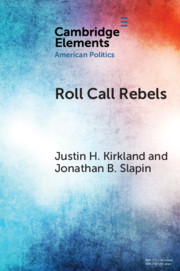Element contents
Roll Call Rebels
Published online by Cambridge University Press: 31 December 2018
Summary
- Type
- Element
- Information
- Series: Elements in American PoliticsOnline ISBN: 9781108568883Publisher: Cambridge University PressPrint publication: 20 December 2018
References
- 22
- Cited by

